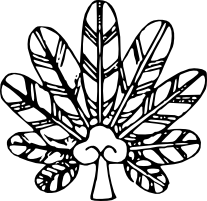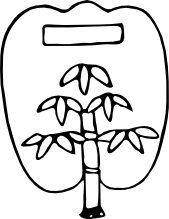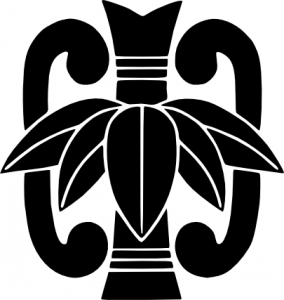Recreational research into Feudal Japan
Posts tagged fans
Motif of the Week: Folding Fans
Jun 14th (a Senshō (先勝))
A while back we talked about one type of fan used in mon, but the type of fan everyone associates with Japan is the standard folding fan. This was a very popular motif in mon through the centuries. Its origins as a design motif date to the Heian period (794–1185).(Dower:110)
Here are two folding fans from our collection of 15th century provincial samurai mon.(KJ:7) The one on the left is a cypress fan, which was part of the traditional court costume, with the number of slats used indicating the status of the holder.(Dower:110) The one on the right is of feathers. It’s stylistically related to the hemp palm mon, and is associated with tengu, the mythical “bird goblins” who would trick mountain travelers with illusions, and from there mountain asceticism and certain temples and shrines.(Dower:111)
A simple folding fan design with the sun-circle motif was used by Satake Yoshinobu at the Battle of Imafuku in 1614, in the early Edo period.(SH:H9,62) This style of papered fan, optionally with design, became the standard version of the folding fan for mon. This particular version is interesting because it breaks the standard two-color rule for mon, which would soon become inviolate, by using three distinct colors: black, white, and red.
Around the same time, we have a three-fan design used by Matsudaira (Okochi) Nobutsua, who we mentioned last week, at the Shimbara Rebellion in 1638.(SH:63) Making circles of fans is similar to the way circles would be made of some plants in mon.
Modern fan mon are very similar to these early Edo designs, but with more realistic handles that hearken back to the earlier fans we have here.(IEJFC:52.2)
Mon of the Week: Fan with Bamboo
May 23rd (a Senshō (先勝))
This week we look at another 15th-century rural samurai mon.(KJ:7) It shows what appears to be a nonfolding paper fan decorated with a bar, possibly the character for “one”, with a bamboo stem with leaves serving as the handle.
This is similar to a mon in use today, depicting a T’ang dynasty fan (唐団扇/tō uchiwa) with bamboo grass (笹/sasa).(IEJFC:39)
The shape of the fan is somewhat different in the more recent mon; my interpretation is that the design became more stylized as mon became standardized in the Edo period. This also shows how earlier mon had more flexibility in combining multiple unrelated elements in ways later mon would not. In addition, the bamboo stem in the modern one has become more stylized, somewhere between an actual bamboo stem and a fan rod. However, these two mon also show the consistency of mon in different eras, even as the ways mon were created, assigned, and used changed.
ADDED INFO:
A similar fan mon with a simplified, filled design and a simple post instead of the bamboo detail was used by Okudaira Nobumasa in the siege of Nagashino Castle in 1575.(SH:D5,59)






